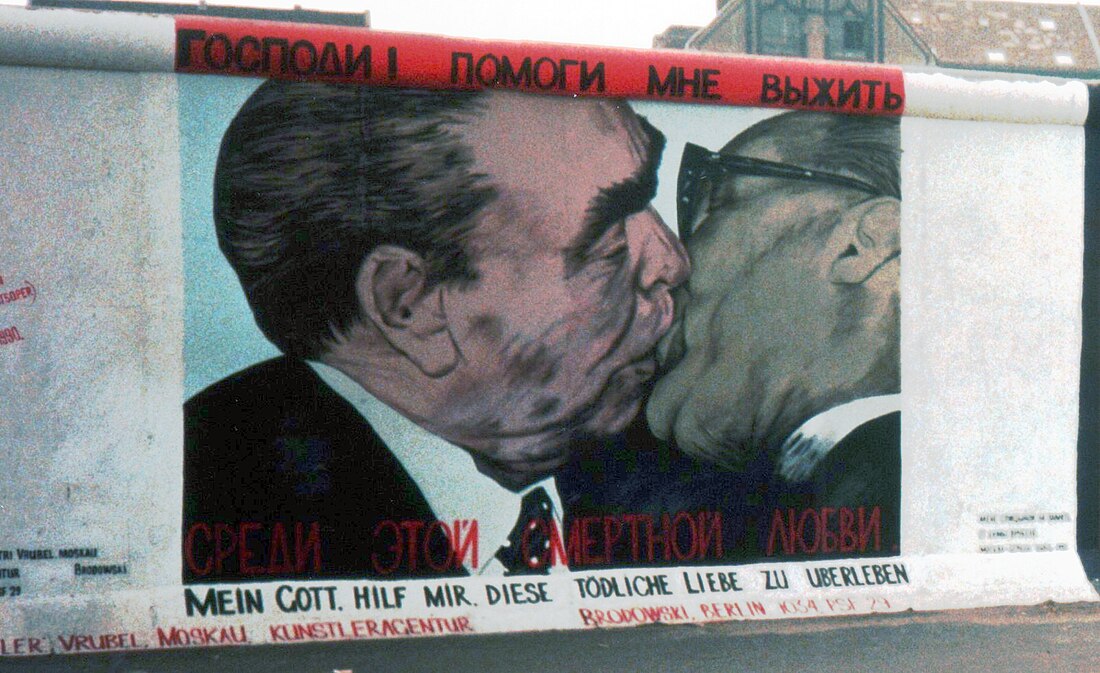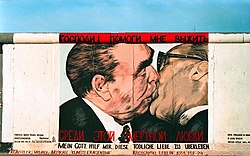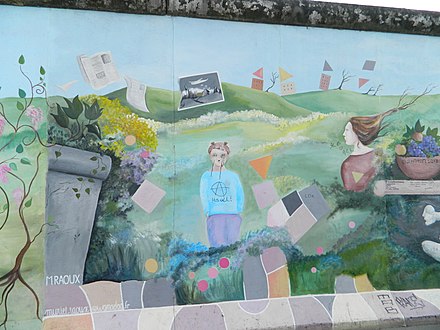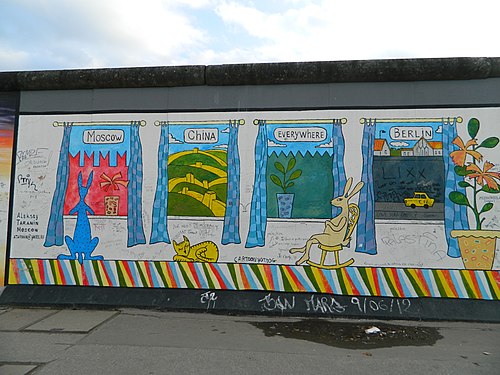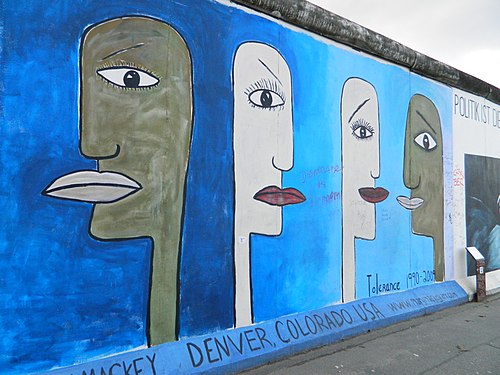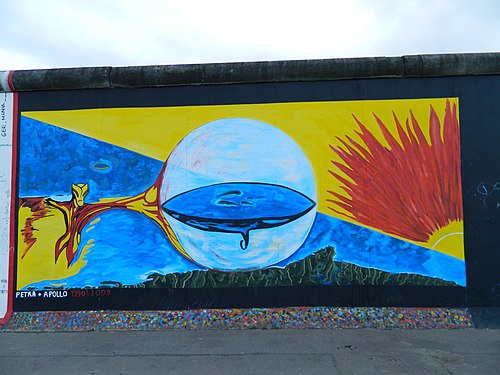East Side Gallery
Berlin Wall Art gallery From Wikipedia, the free encyclopedia
The East Side Gallery (German: East-Side-Gallery) memorial in Berlin-Friedrichshain is a permanent open-air gallery on the longest surviving section of the Berlin Wall in Mühlenstraße between the Berlin Ostbahnhof and the Oberbaumbrücke along the Spree. It consists of a series of murals painted directly on a 1,316 m (4,318 ft) long remnant of the Berlin Wall,[1] located near the centre of Berlin, on Mühlenstraße in Friedrichshain-Kreuzberg.
You can help expand this article with text translated from the corresponding article in German. (March 2013) Click [show] for important translation instructions.
|
 A section of the East Side Gallery, featuring the mural My God, Help Me to Survive This Deadly Love by Dmitri Vrubel | |
| Established | 1990 |
|---|---|
| Location | Mühlenstrasse (Mill Street) Berlin, Germany |
| Type | Art gallery |
| Website | eastsidegalleryexhibition.com |
In the spring of 1990, after the opening of the Berlin Wall, this section was painted by 118 artists from 21 countries. The artists commented on the political changes of 1989/90 in a good hundred paintings on the side of the Wall that was formerly facing East Berlin. Due to urban development measures, it is no longer completely preserved, and instead of the originals from then, only the replicas from 2009 exist today.
The actual border at this point was the Kreuzberg bank of the Spree. The gallery is, for the most part, located on the western wall, which closed off the border area to East Berlin. This wall, facing inwards towards West Berlin, was much thicker and more fortified than its outward-facing counterpart. However, a small portion of the so-called "hinterland" wall has managed to survive, despite its weaker structure, as part of the memorial. Mühlenstrasse, one of the main arterial roads to the south, ran along these border installations. Due to the spatial conditions, the previously usual concrete pipes were already installed here, so that the interior wall in this area was atypically optically, but somewhat elevated, resembling the outer wall.
The gallery has official status as a Denkmal, or heritage-protected landmark. According to the Künstlerinitiative East Side Gallery e.V., an association of the artists involved in the project, "The East Side Gallery is understood as a monument to the fall of the Berlin Wall and the peaceful negotiation of borders and conventions between societies and people", and has more than three million visitors per year.[2]
Description
Summarize
Perspective
The Gallery consists of 105 paintings by artists from all over the world, painted in 1990 on the east side of the Berlin Wall. The actual border at this point had been the river Spree. The gallery is located on the so-called "hinterland mauer", which closed the border to West Berlin.
It is possibly the largest and longest-lasting open air gallery in the world. Paintings from Jürgen Grosse alias INDIANO, Dimitri Vrubel, Siegfrid Santoni, Bodo Sperling, Kasra Alavi, Kani Alavi, Jim Avignon, Thierry Noir, Ingeborg Blumenthal, Ignasi Blanch i Gisbert, Kim Prisu, Hervé Morlay VR and others have followed.
The paintings at the East Side Gallery document a time of change and express the euphoria and great hopes for a better, more free future for all people of the world.

The East Side Gallery was founded following the successful merger of the two German artists' associations VBK and BBK. The founding members were the speche of the Federal Association of Artists BBK Bodo Sperling, Barbara Greul Aschanta, Jörg Kubitzki and David Monti.[3][1]
In July 2006, to facilitate access to the river Spree from the Mercedes-Benz Arena, a 40 m (130 ft) section was moved somewhat west, parallel to the original position.[4]
A 23-meter (75') section was scheduled to be removed on 1 March 2013 to make way for luxury apartments. None of the artists whose work will be destroyed were informed of these plans.[5] The demolition work actually started on 1 March 2013. According to German news FOCUS, authorities were not aware of the start of the demolition. Due to the involvement of protesters, demolition was postponed until at least 18 March 2013.[6]
Renovation
Two-thirds of the paintings are badly damaged by erosion, graffiti, and vandalism. One-third have been restored by a non-profit organization which started work in 2000. The objective of this organization is the eventual restoration and preservation of all the paintings. Full restoration, particularly of the central sections, was projected for 2008. Remediation began in May 2009.
The restoration process has been marked by major conflict. Eight of the artists of 1990 refused to paint their own images again after they were completely destroyed by the renovation. In order to defend the copyright, they founded "Founder Initiative East Side" with other artists whose images were copied without permission.[7] Bodo Sperling launched a test case in the Berlin State Court in May 2011, represented by the Munich art lawyer Hannes Hartung and with the support of the German VG Bild-Kunst. The Court will address the question of whether art should be listed as destroyed and then re-copied without the respective artists' permission. The outcome of the trial will be a landmark declaration for European art law.[8][9][needs update]
Future of the East Side Gallery
As of 1 November 2018, the State of Berlin will be responsible for the "Park an der Spree" and "East Side Park" plots with the elements of the former Berlin Wall known as the "East Side Gallery" from the property of the State of Berlin in the Transfer of ownership to the Berlin Wall Foundation. Parliament approved a proposal from the Senator for Culture and Europe that had passed the main committee. The Berlin Wall Foundation received the mandate for the structural maintenance of the East Side Gallery monument, the maintenance of the associated public green space and the mediation of the historical site of remembrance.[10]
In the future, visitors to the East Side Gallery should receive more information and historical classification. For this purpose, the foundation has launched an extensive management program. The aim of all new mediation offers is to illustrate the unique dual character of the historical place: On the one hand, as an artistic testimony and symbol of joy over the peaceful overcoming of the German division; as a testimony to the GDR border regime on the other hand. Both narratives need to be related in a common narrative.[citation needed]
Artists
This section needs additional citations for verification. (October 2018) |

Featured here is a depiction (painting #25) of Leonid Brezhnev and Erich Honecker kissing as painted by Dmitri Vrubel. On the left is the condition of the painting in 1991 and at the right is the condition after restoration in 2009. The Russian words at the top read "God! help me stay alive"; and continue at the bottom "Among this deadly love."





- Oskar: (Hans Bierbrauer)
- Narenda K. Jain: Die sieben Stufen der Erleuchtung
- Fulvio Pinna: Hymne an das Glück
- Kikue Miyatake: Paradise Out Of The Darkness
- Günther Schaefer: Vaterland
- Georg Lutz Rauschebart
- César Olhagaray: untitled
- Jens-Helge Dahmen: Pneumohumanoiden
- Gábor Simon: Space Magic
- Siegrid Müller-Holtz: Gemischte Gefühle
- Ursula Wünsch: Frieden für Alles
- Oliver Feind, Ulrike Zott: untitled
- Ana Leonor Rodriges
- Muriel Raoux, Kani Alavi: untitled
- Muriel Raoux: Les Yeux Ouverts
- Ditmar Reiter: untitled
- Santoni: Trilogie-Maschine Macht
- Bodo Sperling: The Trans-formation of the penta gram to a peace star in a big Europe without walls
- Barbara Greul Aschanta: Deutschland im November
- Willi Berger: Soli Deo Gloria
- André Sécrit, Karsten Thomas: Du hast gelernt, was Freiheit ist
- Theodor Chezlav Tezhik: The Big Kremlin's Wind
- Catrin Resch: Europas Frühling
- Irina Dubrowskaja: Die Wand muss weichen wenn der Meteorit der Liebe kommt
- Dmitri Vrubel: Mein Gott hilf mir, diese tödliche Liebe zu überleben
- Marc Engel: Marionetten eines abgesetzten Stücks
- Alexey Taranin: untitled
- Michail Serebrjakow: Diagonale Lösung des Problems
- Rosemarie Schinzler: untitled
- Rosemarie Schinzler: Wachsen lassen
- Christine Fuchs: How's God? She's Black
- Gerhard Lahr: Berlyn
- Karin Porath: Freiheit fängt innen an
- Lutz Pottien-Seiring: untitled
- Wjatschleslaw Schjachow: Die Masken
- Dmitri Vrubel: Danke, Andrej Sacharow
- Jeanett Kipka: untitled
- Gamil Gimajew: untitled
- Jürgen Große: Die Geburt der Kachinas
- Christopher Frank: Stay Free
- Andreas Paulun: Amour, Paix
- Kim Prisu (Joaquim A. Goncalves Borregana): 1990 O povo unido nuca sera vencido 2009 Métamorphose des existences
- Greta Csatlòs (Künstlergruppe Ciccolina): Sonic Malade
- Henry Schmidt: Vergesst mir die Liebe nicht
- Thomas Klingenstein: Umleitung in den japanischen Sektor
- Karsten Wenzel: Die Beständigkeit der Ignoranz
- Pierre-Paul Maillé: untitled
- Andy Weiß: Geist Reise
- Gabriel Heimler: Der Mauerspringer
- Salvadore de Fazio: Dawn of Peace
- Gerald Kriedner: Götterdämmerung
- Christos Koutsouras: Einfahrt Tag und Nacht freihalten
- Yvonne Onischke (geb. Matzat; Künstlername seit 2005 Yoni): Berlin bei Nacht
- Peter Peinzger: untitled
- Elisa Budzinski: Wer will, daß die Welt so bleibt, wie sie ist, der will nicht, daß sie bleibt
- Sabine Kunz: untitled
- Jay One (Jacky Ramier): untitled
- Klaus Niethardt: Justitia
- Mirta Domacinovic: Zeichen in der Reihe
- Patrizio Porrachia: untitled
- Ines Bayer, Raik Hönemann: Es gilt viele Mauern abzubauen
- Thierry Noir: untitled
- Teresa Casanueva:[11] untitled
- Stephan Cacciatore: La Buerlinca
- Karina Bjerregaard, Lotte Haubart: Himlen over Berlin
- Christine Kühn: Touch the Wall
- Rodolfo Ricàlo: Vorsicht
- Birgit Kinder: Test the Rest
- Margaret Hunter, Peter Russell: untitled
- Peter Russell: Himmel und Sucher
- Margaret Hunter: Joint Venture
- Sándor Rácmolnár: Waiting for a New Prometheus
- Gábor Imre: untitled
- Pal Gerber: Sag, welche wunderbaren Träumen halten meinen Sinn umfangen
- Gábor Gerhes: untitled
- Sándor Györffy: untitled
- Gruppe Stellvertretende Durstende
- Laszlo Erkel (Kentaur): You can see Infinity
- Kani Alavi: Es geschah im November
- Jim Avignon: Miriam Butterfly, Tomas Fey: Doin it cool for the East Side
- Peter Lorenz: untitled
- Dieter Wien: Der Morgen
- Jacob Köhler: Lotus
- Carmen Leidner: Niemandsland
- Jens Hübner, Andreas Kämper: untitled
- Hans-Peter Dürhager, Ralf Jesse: Der müde Tod
- Jolly Kunjappu: Dancing to Freedom
- Susanne Kunjappu-Jellinek: Curriculum Vitae
- Mary Mackey: Tolerance
- Carsten Jost, Ulrike Steglich: Politik ist die Fortsetzung des Krieges mit anderen Mitteln
- Brigida Böttcher: Flora geht
- Ignasi Blanch i Gisbert: Parlo d'Amor
- Kiddy Cidny: Ger-Mania
- Petra Suntinger, Roland Gützlaff: untitled
- Andrej Smolak: untitled
- Youngram Kim-Holdfeld: untitled
- Karin Velmanns: untitled
- Rainer Jehle: Denk-Mal, Mahn-Mal
- Kamel Alavi: untitled
- Kasra Alavi: Flucht
- Ingeborg Blumenthal: Der Geist ist wie Spuren der Vögel am Himmel
- Youngram Kim
Awards
In popular media
- The gallery was seen in Wolfgang Becker's movie Goodbye, Lenin!
- The gallery was featured in the fifth leg of The Amazing Race 6 and the sixth leg of The Amazing Race 32.[14][15]
- The gallery was featured in English indie/rock band Bloc Party's single Kreuzberg taken from the album A Weekend in the City
- Panel 32, Gerhard Lahr's "Berlyn", is seen in Anton Corbijn's video for U2's song One.
East Side Gallery photos
These images are covered by German freedom of panorama rules.[16]
See also
References
Literature
External links
Wikiwand - on
Seamless Wikipedia browsing. On steroids.
